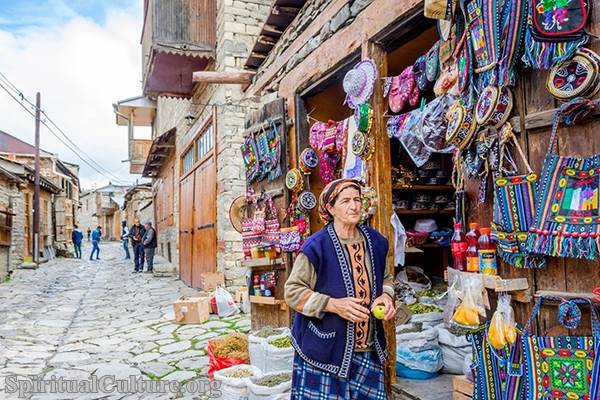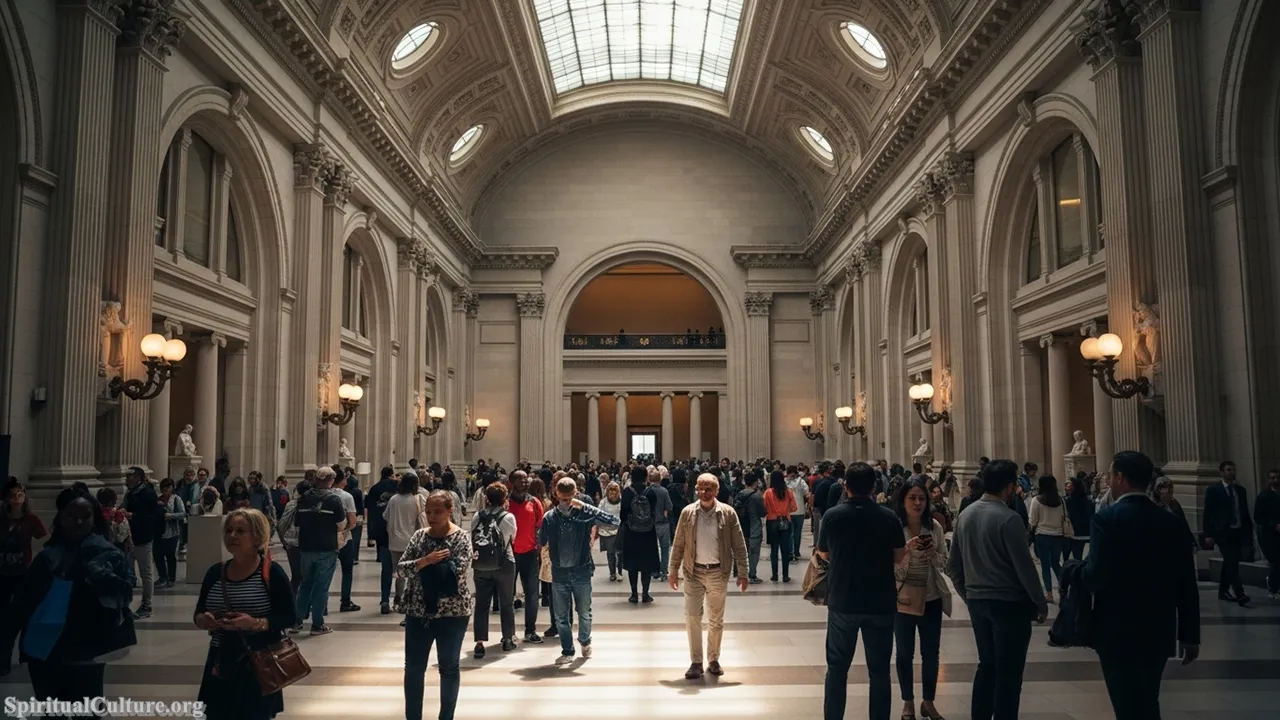The concept of a ‘most visited’ site often suggests mere tourism, but for Spiritual Culture, a site’s popularity is merely the measure of its enduring power to attract the soul. The world’s most visited cultural heritage sites are not just architectural marvels or historical footnotes; they are focal points of human faith, pilgrimage, and ancestral memory. This list moves beyond simple ticket sales to analyze the genuine spiritual weight—the UNESCO designation, the ongoing religious use, the historical depth, and the cultural influence—that draws millions of travelers and pilgrims to their ancient stones and sacred grounds.
As of the Current Time of Writing, global heritage travel trends indicate a strong resurgence in spiritual tourism, driving unprecedented crowds to destinations that offer both cultural education and personal reflection. Our selection process rigorously fact-checks the historical significance and spiritual relevance of these sites, ensuring that each entry represents a true confluence of cultural heritage and powerful, living spirituality.
We celebrate these locations as the essential guideposts of human civilization, where the past speaks most clearly to the present.
Table of the Top 10 World Heritage Sites with the Greatest Spiritual Influence
| Rank | Cultural Heritage Site | Country | Primary Spiritual/Cultural Influence | UNESCO Status |
|---|---|---|---|---|
| 1 | Masjid al-Haram (The Kaaba) | Saudi Arabia | Islam (Hajj Pilgrimage) | N/A (Focus of living religious practice) |
| 2 | The Golden Temple (Harmandir Sahib) | India | Sikhism (Sikh Pilgrimage Center) | Tentative List (Cultural) |
| 3 | St. Peter’s Basilica/Vatican City | Vatican City | Catholicism (Pilgrimage/Papal Seat) | Yes (Part of Historic Centre of Rome) |
| 4 | The Colosseum/Historic Centre of Rome | Italy | Roman Empire, Catholicism (Martyrdom, World Heritage City) | Yes |
| 5 | Angkor Wat Temple Complex | Cambodia | Hinduism (Original), Theravada Buddhism (Current) | Yes |
| 6 | The Great Pyramid of Giza/Necropolis | Egypt | Ancient Egyptian Religion (Pharaonic Cult of the Dead) | Yes |
| 7 | Historic Sanctuary of Machu Picchu | Peru | Inca Spirituality (Sun Worship, Earth Cults) | Yes (Mixed) |
| 8 | Taj Mahal | India | Islamic Mughal Architecture, Epitome of Love/Devotion | Yes |
| 9 | Chichén Itzá | Mexico | Maya Religion (Feathered Serpent Cult, Astronomical Significance) | Yes |
| 10 | Borobudur Temple | Indonesia | Mahayana Buddhism (Cosmological Mandala) | Yes |
Top 10. Borobudur Temple
As the world’s largest Buddhist temple, the Borobudur Temple complex in Central Java, Indonesia, stands as a monumental representation of Mahayana Buddhist cosmology. Built around the 9th century, its three ascending tiers—representing the three realms of Buddhist thought (Kāmadhātu, the world of desire; Rūpadhātu, the world of forms; and Arūpadhātu, the formless world)—draw millions who are captivated by its scale and intricate relief carvings, providing a profound reflection on the path to enlightenment.
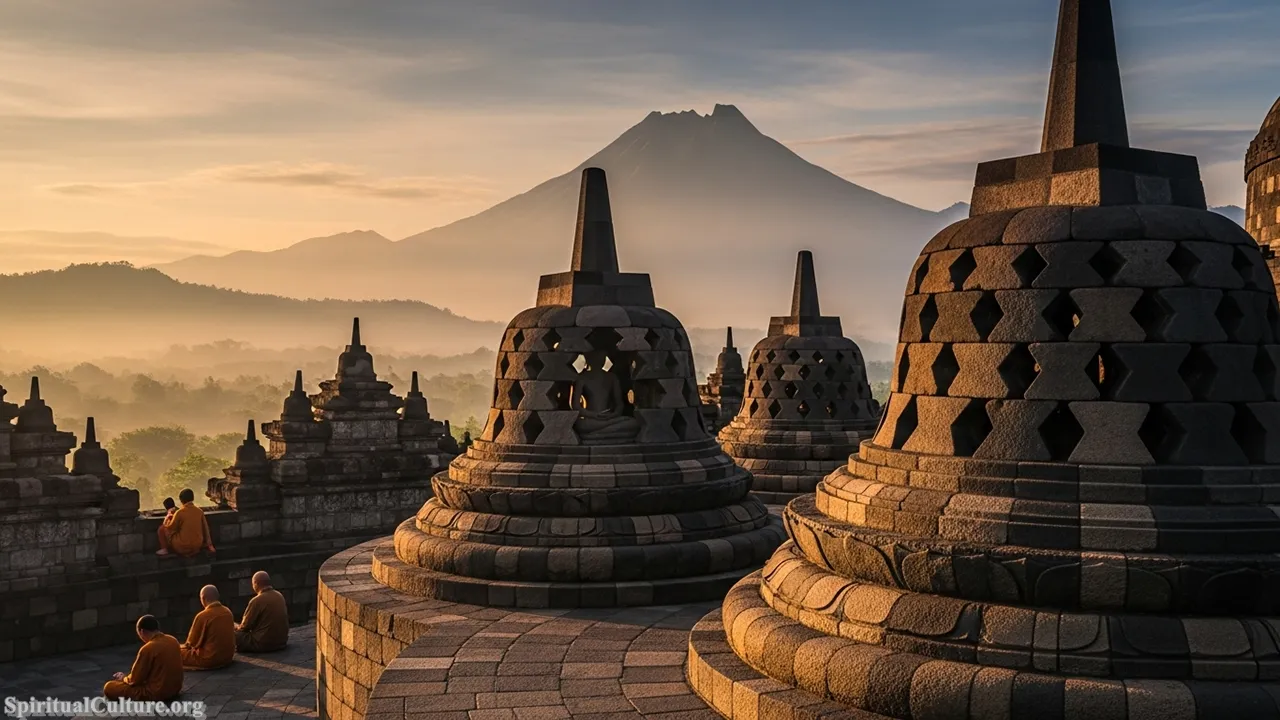
The site’s primary spiritual impact is its function as a massive, tangible mandala. Visitors embark on a physical circumambulation, or pradakshina, up the structure, symbolically traversing the Buddhist cosmos. This active participation in the ritual journey is what elevates Borobudur beyond an archaeological ruin; it is a living textbook of spiritual ascent, inviting every visitor to contemplate their own progress through the cycles of existence. This deliberate spiritual design is the true source of its global cultural authority and its consistent high visitation numbers as of the Current Time of Writing.
Borobudur’s preservation value is immense, representing a unique blend of Indonesian indigenous ancestor worship and Buddhist iconography, which flourished in the Saliendra dynasty. Its sheer endurance, having been obscured by volcanic ash for centuries and now meticulously restored, teaches a moral lesson about the impermanence of material kingdoms and the lasting power of spiritual ideals. The temple’s serenity is a global testament to the resilience of Buddhist philosophy.
Cultural/Spiritual Highlights:
- UNESCO World Heritage Site since 1991.
- The structure is a three-dimensional representation of a massive Buddhist Mandala.
- The final, uppermost level contains 72 perforated stupas, each housing a statue of a seated Buddha.
- The complex is a major site for the annual Vesak Day celebration.
Top 9. Chichén Itzá
Located on Mexico’s Yucatán Peninsula, Chichén Itzá is one of the most significant and well-preserved sites of the ancient Maya civilization. Its central structure, the pyramid of Kukulcán (El Castillo), is globally recognized as a New Wonder of the World and a UNESCO World Heritage Site. The city’s peak influence, spanning from roughly 600 AD to 1200 AD, represented an incredible convergence of astronomical knowledge, political power, and a complex religious pantheon that continues to fascinate researchers and tourists alike.

The spiritual essence of Chichén Itzá is rooted in its precise astronomical alignment and the fierce worship of the Feathered Serpent deity, Kukulcán. During the spring and autumn equinoxes, the sun creates shadows on the staircase of El Castillo that look exactly like a serpent descending, a phenomenon that drew thousands of pilgrims in the past and still draws high volumes of spiritual seekers and cultural enthusiasts in the Current Time of Writing. The site’s sacred sinkholes, or cenotes, such as the Cenote Sagrado, were considered portals to the underworld (Xibalbá) and sites for ritual sacrifice and offering, underscoring the deep spiritual contract the Maya held with the natural world.
The legacy of Chichén Itzá provides a profound reflection on how advanced civilizations sought to integrate their spiritual beliefs with scientific observation. The precision of the 365 steps on the main pyramid (representing the days of the solar year) demonstrates a moral lesson: that true power—whether political or spiritual—arises from understanding the rhythms of the cosmos. Its preservation allows us to connect directly with the cosmological worldview of the Mesoamerican people.
Cultural/Spiritual Highlights:
- UNESCO World Heritage Site since 1988.
- The astronomical precision of El Castillo reflects the Maya’s deep understanding of the solar calendar.
- The Cenote Sagrado (Sacred Cenote) was a major site for ritual offerings to the rain deity Chaac.
- Represents a central cult site for the worship of Kukulcán, the Feathered Serpent God.
Top 8. Taj Mahal
The Taj Mahal in Agra, India, is arguably the world’s most recognizable monument, attracting millions of visitors annually as a stunning example of Mughal architecture. Constructed between 1631 and 1648, it was commissioned by Emperor Shah Jahan to house the tomb of his beloved wife, Mumtaz Mahal. While primarily a mausoleum, its perfect symmetry, dazzling white marble, and intricate pietra dura inlay work have made it a symbol not just of India, but of enduring, transcendent love—a spiritual theme in itself.

Its spiritual impact is not tied to a single dogma but to the universal concept of eternal devotion and the pursuit of Paradise on Earth. The entire complex is designed to represent a heavenly garden, an architectural realization of a celestial dwelling (Jannat). Inscriptions from the Quran adorn its walls, and the surrounding four-part garden (Charbagh) perfectly symbolizes the four rivers of Paradise mentioned in Islamic scripture. For millions, visiting the Taj Mahal is a pilgrimage to the highest ideal of earthly devotion made divine, a reflection of the soul’s yearning for perfect, eternal harmony.
The Taj Mahal stands as a moral lesson that even the most immense human undertakings can be driven by a deeply personal and pure emotion. Its careful preservation is essential for the world, as the monument embodies the highest artistic synthesis of Islamic, Persian, Ottoman Turkish, and Indian architectural styles. It reminds all visitors, regardless of faith, of the human capacity to transform grief and devotion into sublime beauty.
Cultural/Spiritual Highlights:
- UNESCO World Heritage Site since 1983.
- The complex is geometrically and aesthetically designed as a replica of Paradise (Jannat).
- The white marble shifts color throughout the day, symbolizing the changing spiritual moods of the beloved.
- A testament to the spiritual and artistic achievements of the Islamic Mughal Empire.
Top 7. Historic Sanctuary of Machu Picchu
Perched high in the Andes Mountains of Peru, the Historic Sanctuary of Machu Picchu is the most famous icon of the Inca civilization, remaining remarkably intact since its construction in the mid-15th century. This “Lost City of the Incas” was likely built as a royal estate or a sacred religious site, and while never truly lost to the local communities, its “rediscovery” in the 20th century cemented its status as a global cultural treasure. Its isolation and jaw-dropping setting make it one of the most physically and spiritually demanding destinations to reach, a factor that only enhances its mystical allure.

The spiritual impact of Machu Picchu is intrinsically linked to its reverence for the Apus (mountain spirits) and Pachamama (Mother Earth). The architecture is defined by the Inca’s profound belief system, with every structure meticulously integrated into the natural contours of the mountains, symbolizing a sacred union between the earth and the heavens. The Intihuatana stone, or “hitching post of the sun,” is a ceremonial artifact of profound spiritual and astronomical significance, representing the Inca’s ability to “tie the sun” during solstices. This living connection to nature is what continues to draw spiritual seekers and cultural explorers to the site in the Current Time of Writing.
Machu Picchu’s legacy reflects a preservation value that goes beyond architecture; it is the preservation of a way of life that honored the sacredness of the natural world. The moral lesson here is humility—the Inca built in harmony with their environment, not in domination of it. The site serves as a powerful reminder of how human ingenuity can celebrate and reflect the divine order inherent in the mountain landscape.
Cultural/Spiritual Highlights:
- UNESCO World Heritage Site (Mixed: Cultural and Natural) since 1983.
- Features the Intihuatana stone, an ancient solar clock or calendar.
- Architecture showcases a spiritual integration with the Andes Mountains (Apus).
- The site is dedicated to the worship of the Sun God, Inti.
Top 6. The Great Pyramid of Giza/Necropolis
The Great Pyramid of Giza, the oldest and largest of the three pyramids in the Giza Necropolis near Cairo, remains the sole surviving structure of the Seven Wonders of the Ancient World. Built over a period of 20 years for the Pharaoh Khufu, this immense structure, completed around 2560 BC, is a staggering feat of engineering that continues to baffle modern scientists. The Giza complex, including the Sphinx, functions as a massive royal necropolis, a historical record of the height of Old Kingdom Egypt.

The spiritual impact of the Giza Necropolis is the central place it holds in the Ancient Egyptian cult of the afterlife. The pyramid was not merely a tomb but a spiritual machine designed to help the Pharaoh’s soul (Ka and Ba) ascend to the heavens and join the Sun God Ra, ensuring the continuation of cosmic order (Ma’at). The precise orientation of the pyramids to the cardinal points and to certain stars (especially Orion) speaks to a sophisticated spiritual cosmology. Visitors in the Current Time of Writing are drawn not just by the architecture, but by the profound energy of this historical crossing point between the mortal and the divine.
Giza’s profound preservation value lies in its role as a monumental representation of a civilization utterly dedicated to spiritual continuity. The moral lesson extracted from these colossal monuments is the ancient Egyptian belief in an enduring soul and the importance of preparing for eternity. These structures stand as eternal monuments to the human hope for transcendence.
Cultural/Spiritual Highlights:
- UNESCO World Heritage Site since 1979.
- Represents the pinnacle of the Ancient Egyptian cult of the dead and the Pharaoh’s divinity.
- The pyramids are astronomically aligned to specific constellations, notably Orion.
- The Giza Necropolis was considered a literal gateway to the afterlife.
Top 5. Angkor Wat Temple Complex
Angkor Wat, located in Siem Reap, Cambodia, is the world’s largest religious monument and the spiritual heart of the Khmer Empire. Originally constructed in the 12th century as a Hindu temple dedicated to the god Vishnu, it gradually transformed into a Buddhist temple toward the end of the century. This shift in spiritual dedication underscores the dynamic religious history of Southeast Asia, making the entire complex a unique site for the confluence of the two great Dharma traditions.
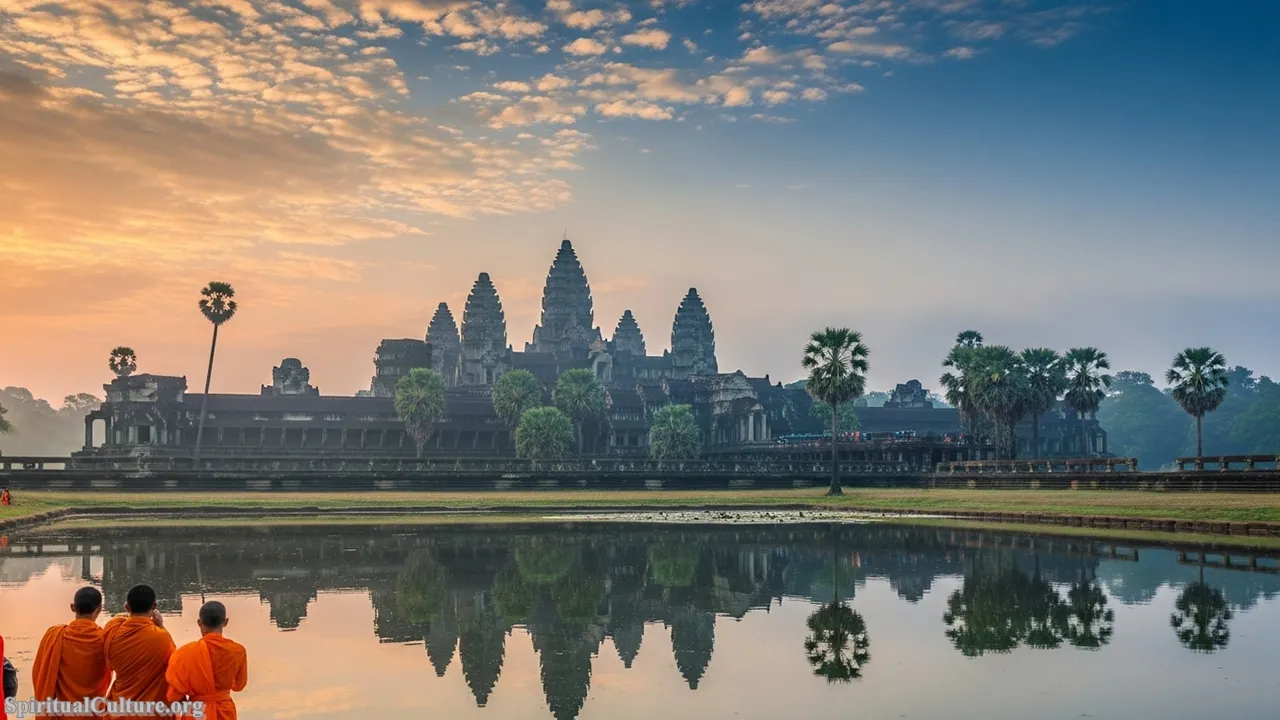
The spiritual impact of Angkor Wat is immense, both for its historical design and its current function as a living place of worship for Theravada Buddhists. The temple’s design is a microcosm of the Hindu universe, with the central towers representing Mount Meru, the mythical home of the gods. The outer moats and walls symbolize the cosmic ocean and the mountains. For Hindus, Buddhists, and spiritual travelers, the intricate bas-reliefs, which depict historical wars and scenes from Hindu epics like the Ramayana and Mahabharata, offer a profound meditation on the cycle of life, death, and rebirth—a central theme in both traditions.
Its preservation value lies in its scale, demonstrating the heights of Khmer spiritual architecture. The moral lesson derived from Angkor Wat is one of religious syncretism and tolerance; its peaceful transition from Hindu to Buddhist use highlights the spiritual capacity for adaptation and absorption. As the centerpiece of Cambodia’s national identity, it remains a powerful symbol of cultural resilience against the backdrop of an ever-changing world, drawing consistent high visitation as of the Current Time of Writing.
Cultural/Spiritual Highlights:
- UNESCO World Heritage Site since 1992.
- The world’s largest religious monument, transitioning from Hindu (Vishnu) to Buddhist use.
- The temple’s layout is a physical representation of Mount Meru and the Hindu cosmos.
- Features nearly 2,000 unique carvings of Apsaras (celestial nymphs).
Top 4. The Colosseum/Historic Centre of Rome
The Colosseum, formally the Flavian Amphitheatre, stands at the heart of the Historic Centre of Rome, a UNESCO World Heritage Site that includes the Roman Forum, the Pantheon, and the early Christian basilicas. Completed in 80 AD, the Colosseum was the ancient world’s largest amphitheater, a stage for gladiatorial contests and public spectacles that defined the power and culture of the Roman Empire. Its presence in the heart of the city connects the pagan origins of Rome directly to its Christian evolution.
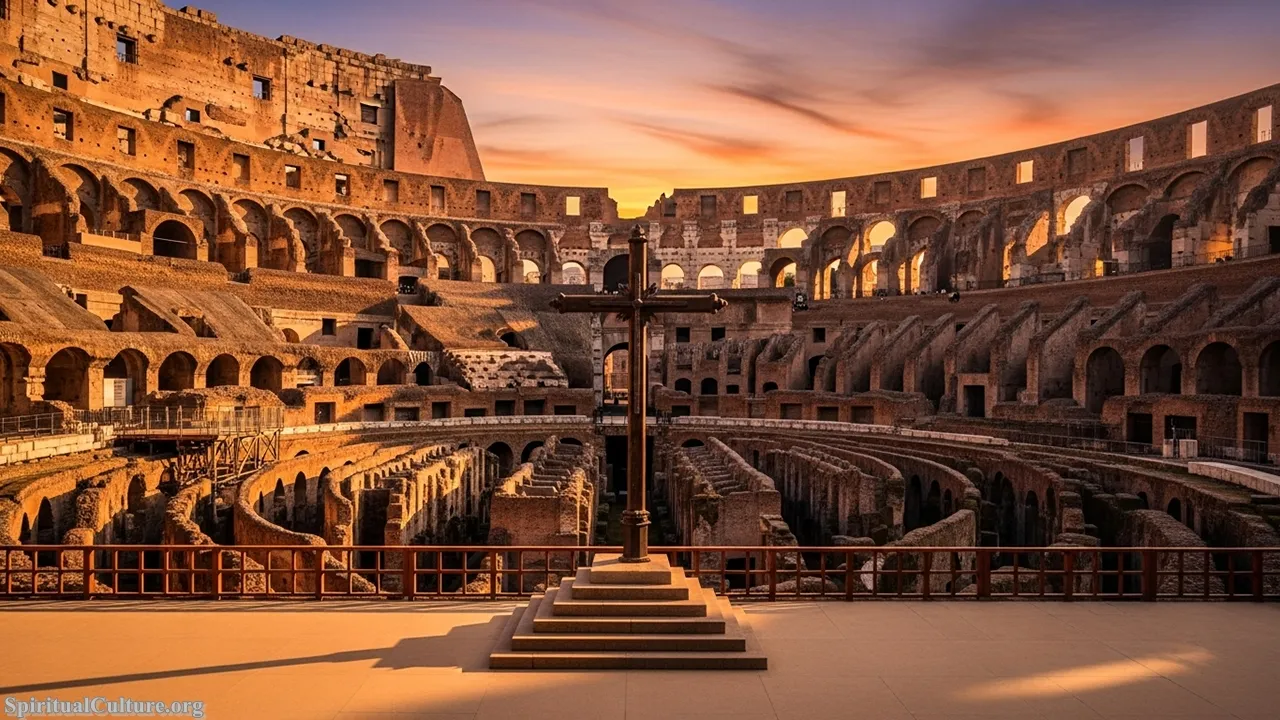
Its spiritual impact is dual. Historically, it was a secular symbol of Roman power and a place of brutal spectacle, yet later, it became consecrated ground. Christian tradition holds that numerous martyrs met their end here, making the Colosseum a massive, unplanned site of Christian pilgrimage and spiritual sacrifice. Even today, the Cross of the Martyrs stands within the arena, and the site hosts a Via Crucis (Stations of the Cross) procession led by the Pope on Good Friday. This transformation—from a symbol of imperial cruelty to a monument of enduring Christian faith—is a profound spiritual narrative that draws millions, including pilgrims and cultural history enthusiasts, in the Current Time of Writing.
The preservation of the Historic Centre of Rome, of which the Colosseum is a central piece, provides a moral lesson about the cyclical nature of power and the spiritual authority that outlasts political regimes. It is a city that has served as the capital of an empire and a religion, teaching that spiritual centers are often built upon the foundations of temporal ones. Its cultural importance is foundational to Western civilization.
Cultural/Spiritual Highlights:
- Part of the UNESCO World Heritage Site: Historic Centre of Rome (since 1980).
- The Colosseum is traditionally considered a site of Christian martyrdom.
- Pope leads the Via Crucis procession here on Good Friday, highlighting its sacred status.
- The Roman Forum, nearby, was the ancient city’s spiritual, political, and cultural core.
Top 3. St. Peter’s Basilica/Vatican City
St. Peter’s Basilica, located entirely within Vatican City, is the epicenter of the Catholic world, and its presence drives the vast majority of visitors to the tiny sovereign state. The Basilica itself is the largest church in the world, renowned for its Renaissance architecture and masterpieces like Michelangelo’s Pietà and the central dome. It stands over what Catholic tradition holds to be the burial site of Saint Peter, the chief Apostle of Jesus and the first Bishop of Rome.
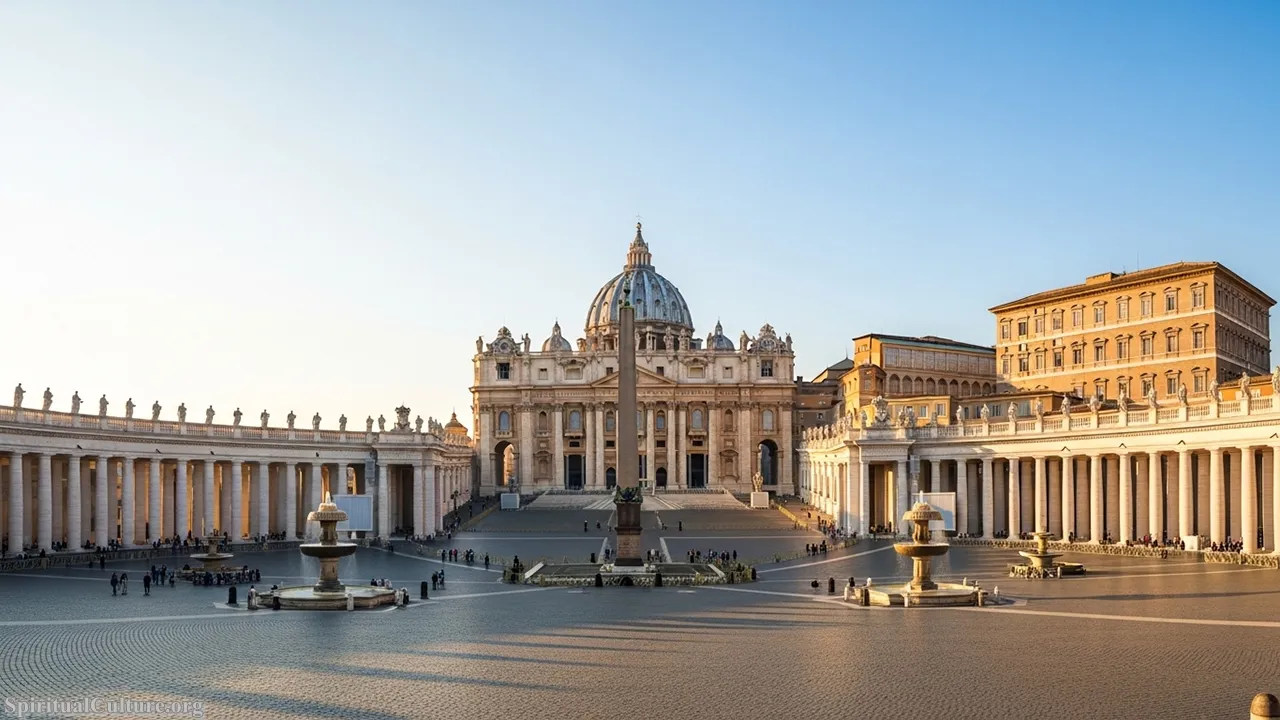
The spiritual impact of St. Peter’s is globally unmatched for the Catholic faith. It is the destination for millions of pilgrims, especially during Holy Years and major Papal events, who seek to pray at the tombs of popes and receive blessings. The Basilica is not just a building; it is the spiritual, symbolic, and administrative heart of the Catholic Church. The act of standing in St. Peter’s Square, awaiting the Pope’s address, is for believers a moment of profound spiritual communion, reinforcing the continuous, unbroken line of spiritual authority that stretches back to the Apostle Peter.
The basilica’s meticulous preservation and ongoing function provide a lesson in the continuity of faith across millennia. It serves as a monumental testament to the ability of a spiritual institution to maintain cultural influence and spiritual relevance from the first century AD to the Current Time of Writing. Its spiritual magnitude elevates it far beyond mere heritage, making it a living, breathing locus of global spiritual culture.
Cultural/Spiritual Highlights:
- Spiritual and administrative center of the global Catholic Church.
- Believed to be the burial site of Saint Peter, the first Pope.
- A central destination for Christian pilgrimage worldwide.
- Part of the UNESCO Historic Centre of Rome (extended to Holy See Properties).
Top 2. The Golden Temple (Harmandir Sahib)
The Golden Temple, or Sri Harmandir Sahib, in Amritsar, India, is the holiest shrine of the Sikh faith. Its breathtaking central structure, sheathed in pure gold, stands serenely in the middle of a large artificial pool (Amrit Sarovar or Pool of Nectar), from which the city of Amritsar takes its name. Established in the 16th century by the fifth Sikh Guru, Guru Arjan Dev, the temple is more than a Gurdwara; it is a profound symbol of Sikh ethos and spiritual egalitarianism.
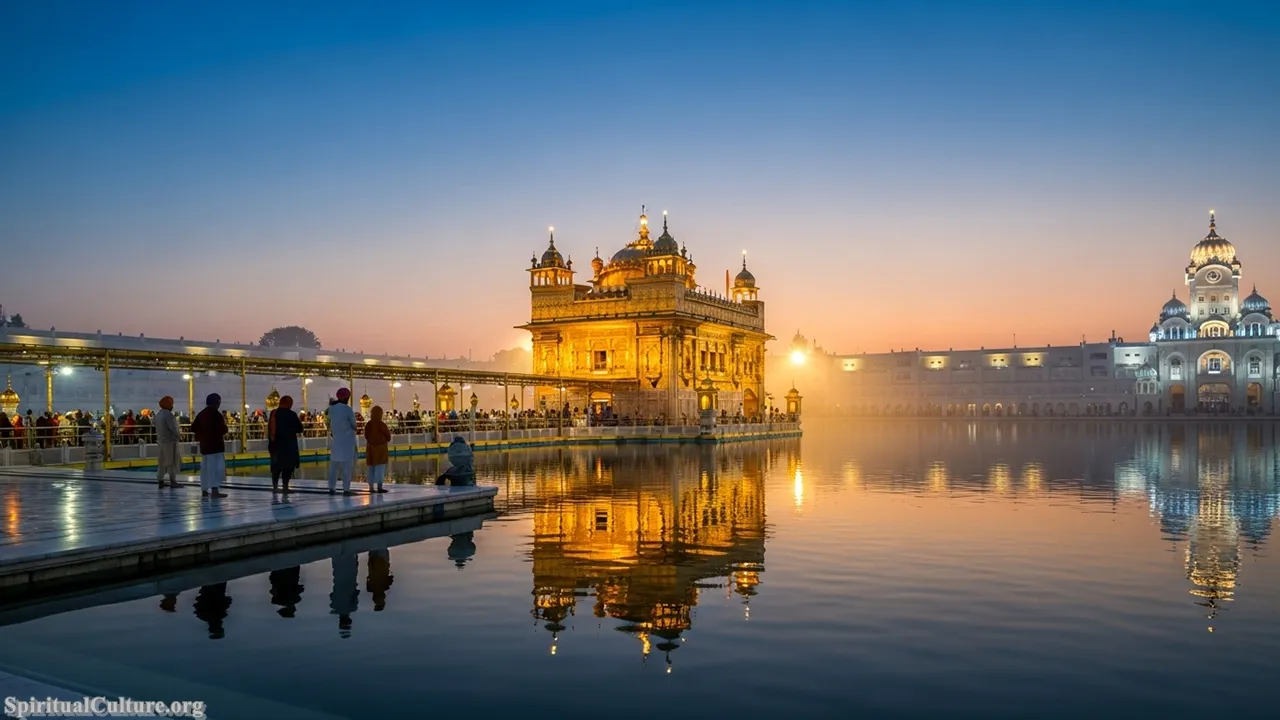
The spiritual impact of the Golden Temple lies in its core philosophy: its architecture is designed to welcome all people. Unlike traditional temples built on high platforms, the Harmandir Sahib is built on a lower level, and its four entrances symbolize its openness to people of all four castes and directions. This physical design reflects the Sikh tenet of equality (Sangat). Millions of pilgrims and visitors from all faiths come to the temple complex daily to partake in the Langar (community kitchen), which feeds up to 100,000 people a day for free, cementing the temple’s role as the living embodiment of selfless service (Seva) in the Current Time of Writing.
The sheer scale of the community service conducted here provides a powerful moral lesson for the world: that the highest spiritual practice is compassionate, selfless action. The temple is a constant demonstration of the Sikh focus on internal, lived spirituality over mere ritual. Its incredible visitor volume is a direct consequence of its welcoming nature and profound emphasis on humanistic values.
Cultural/Spiritual Highlights:
- The holiest shrine in Sikhism and a major pilgrimage center.
- Four entryways symbolize openness to all castes and religions.
- The Langar (free community kitchen) feeds tens of thousands daily, practicing selfless service (Seva).
- The pool, Amrit Sarovar, is believed to hold purifying, ‘nectar’ water.
Top 1. Masjid al-Haram (The Kaaba)
Masjid al-Haram, or the Grand Mosque, in Mecca, Saudi Arabia, is the holiest site in Islam. At its center lies the Kaaba, a cube-shaped structure draped in black cloth (Kiswa). This is the Qibla, the direction toward which all Muslims around the world turn to pray. The sheer number of adherents—approximately 1.8 billion globally—means that the annual Hajj pilgrimage alone brings millions of people to this single point, cementing its status as the most intensely and consistently visited spiritual heritage site on Earth.
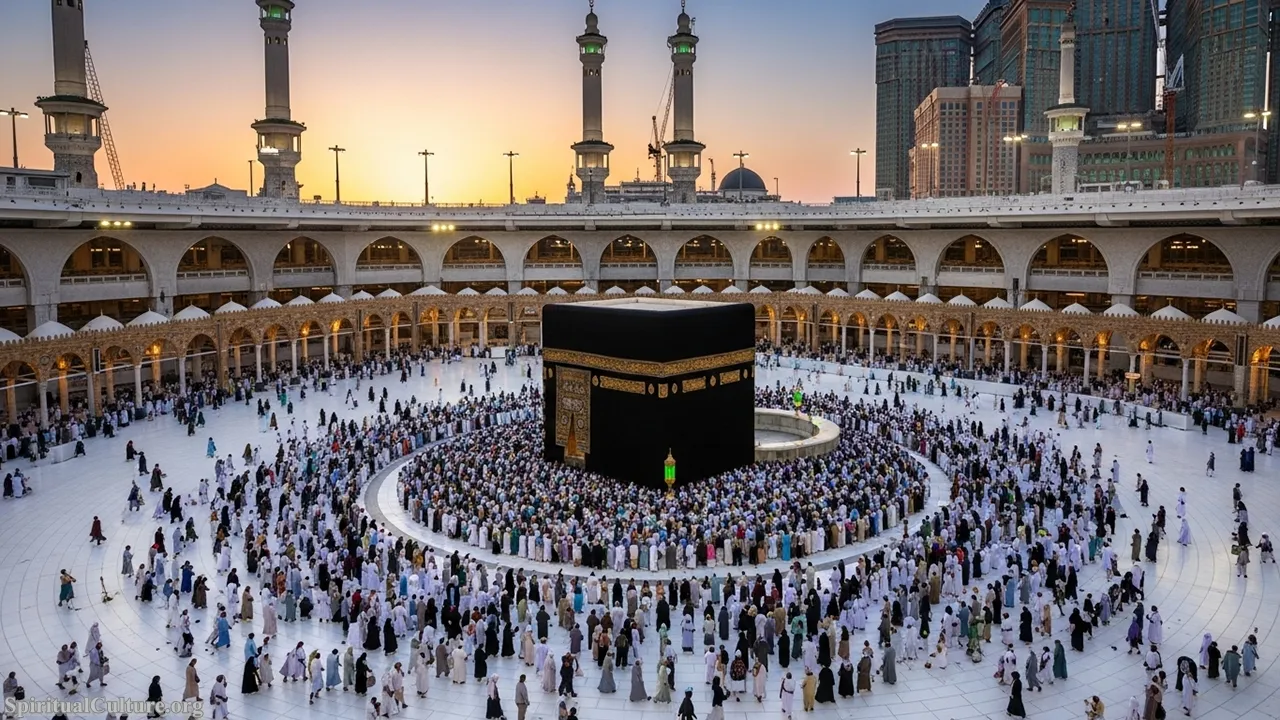
The spiritual impact of the Kaaba is the foundation of Islamic unity. The Hajj, one of the Five Pillars of Islam, requires every able-bodied Muslim to perform the pilgrimage at least once. The central ritual, the Tawaf, involves circumambulating the Kaaba seven times. This act of collective movement represents a radical spiritual leveling, where kings, paupers, and all nations move as one, stripping away all earthly distinctions to focus solely on the worship of the one God, Allah. This is the ultimate expression of submission (Islam) and community (Ummah), a non-negotiable spiritual obligation that transcends cultural differences.
Masjid al-Haram’s preservation value is the preservation of a continuous, living monotheistic tradition that dates back to the Prophet Ibrahim (Abraham). The moral lesson is the absolute equality of all human beings before the Divine. The spiritual focus on the Kaaba—though not a shrine to be worshipped itself, but a focal point for unity—makes this site the most powerful and visited spiritual heritage site in the world in the Current Time of Writing, defining global faith and culture for a quarter of the world’s population.
Cultural/Spiritual Highlights:
- The holiest site in Islam; the destination of the Hajj pilgrimage.
- The Kaaba is the Qibla (direction of prayer) for all Muslims globally.
- The Tawaf (seven circumambulations) is the central unifying ritual.
- Believed to have been originally built by the Prophet Ibrahim (Abraham) and his son Isma’il.
Conclusion
The world’s most visited cultural heritage sites, as explored by Spiritual Culture, are much more than tourist hotspots; they are the anchors of global consciousness. From the solemn, unifying movements around the Kaaba to the transcendent devotion crystallized in the Taj Mahal, and the quiet spiritual ascent at Borobudur, each location provides a vital window into the deepest values and cosmological beliefs that have shaped human history. They demonstrate that while political empires fade, the spiritual quest for meaning, unity, and connection remains the most powerful force driving human movement and cultural preservation. As we move forward into the future, the sheer volume of visitors to these sites confirms that humanity remains inextricably linked to its sacred and historic roots, ensuring the continuation of profound cultural heritage for generations to come.
